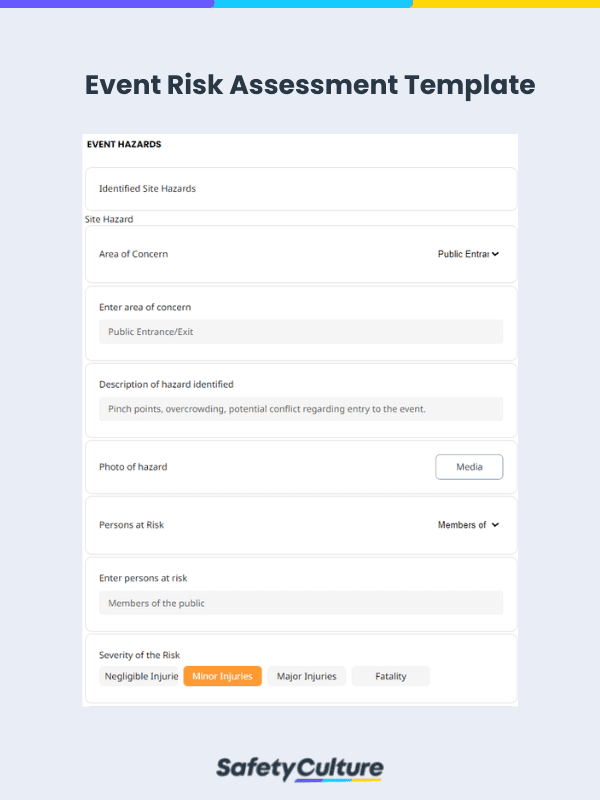What is Event Risk Assessment?
An event risk assessment is a practice of identifying potential safety hazards that could occur before, during, and after an event. It can help event planners and coordinators prepare for emergencies and ensure events run safely.
The Importance of Event Risk Assessments
The likelihood of hazards occurring increases when more people are involved in both the preparation and the execution of an event. A single, overlooked detail can be disastrous. Conducting a event risk assessment helps to minimize the risk of preventable hazards from occurring. Using event risk assessment templates and forms, as shown in the image below, can significantly improve safety and help ensure a successful event by establishing proper preventive measures to avoid accidents and injuries.
Event Hazards Examples
Here are the top 5 event hazards that planners need to be aware of and prepare for while conducting an event risk assessment:
- Riot crowd / Commotion: People at concerts and other popular events can get unruly.
- Falling equipment / Improper placement of equipment: It’s common for events, both indoors and outdoors, to utilize massive audiovisual equipment.
- Lightning strikes during outdoor events: It’s tempting to ignore a little lightning when people are having fun at an outdoor concert or activity, but an open field is highly susceptible to lightning strikes.
- Insufficient medical assistance: Even with an event risk assessment, events are still inherently unpredictable and accidents involving injuries may occur.
- Unsafe food and beverages: Improper transportation and storage of food and beverages to be served at the event can cause outbreaks of foodborne illness.
What are the 4 steps of an event risk assessment?
The responsibility of an organizer is to ensure that all people involved in an event are kept safe throughout the event. This makes the event preparation a serious and stressful process to take. Here is the step-by-step procedure for carrying out and writing an event risk assessment:
#1 Identify potential hazards
It is the event planner’s responsibility to coordinate with staff and contractors to ensure that equipment, amenities, venue facilities, and consumables are safe and that sufficient security is implemented before, during, and after an event.
Some tips for preventing the top 5 event hazards:
- Ensure that there are enough security officers spread out in the area to prevent a commotion from escalating to a full-scale riot. Security staff must also be trained to quickly assess situations and make the right decisions.
- Minimize the risk of equipment injuring people by strategically placing them. Speakers and lights must be placed on solid, stable stands and cables must be taped down.
- Have emergency tents ready for people to evacuate to in case lightning becomes apparent. Consider moving the event to a nearby indoor building if the storm worsens.
- Make arrangements to have trained first aid staff with the proper medical equipment ready to assist. There must also be a clear pathway for ambulances to go through.
- Ensure that the caterer/s or vendor/s have the regulatory licenses needed to certify the safety of the food they serve.
#2 Assessing the risks, its levels, and severity
After all potential hazards are listed and determined, the risks, their levels, and severity should be evaluated thoroughly. This assesses the likelihood of these risks and the consequences associated that may occur during the event. The likelihood should answer the question “How likely is the person to be injured if exposed to the hazard?”, and the consequences should determine how bad the most severe injury will be if exposed to the hazard. Read more about risk assessment here.
#3 Managing the risks
This is the last phase of the event risk assessment where actions, measures, and safety protocols are established. This helps with eliminating, reducing, and mitigating the risks. This includes removing the hazards entirely (elimination), replacing dangerous equipment with a safer one (substitution), containing or placing the hazard on a guarded design (engineering), training key individuals, and thoroughly monitoring the procedures (administrative), and usage of personal protective equipment (PPE).
#4 Recording the findings
All findings must be documented so that it can be reviewed and revised for future safety purposes. By using digital recordkeeping tools, organizers can easily conduct and document event risk assessments while using their mobiles and tablets. These records provide evidence of the assessments carried out that can be a good basis for best event planning practices.
Event Risk Management Plan Sample
Below is a sample of an event risk management plan for an outdoor concert:
Area of Concern: Crowd Management
Description of Event Hazard:
– Pinch points
– Overcrowding
– Potential conflict regarding entry to the event
Persons at Risk:
Senior citizens and persons with disabilities (PWDs)
Severity of the Risk: Minor Injuries
Likelihood of the Risk: Unlikely
List preventive measure/s taken:
– Public Address (PA) system in place
– Appropriate number of identifiable marshals on site with radio system
– Marshals have been fully briefed prior to the event
List measure/s that can be taken to further minimize the risk:
Implement a limit on the number of attendees



